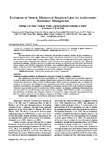Please use this identifier to cite or link to this item:
http://www.alice.cnptia.embrapa.br/alice/handle/doc/490392| Title: | Evaluation of genetic mixtures of sorghum lines for anthracnose resistance management. |
| Authors: | COSTA, R. V. da  CASELA, C. R.   ZAMBOLIM, L.   SANTOS, F. G.   VALE, F. X. R. do   |
| Affiliation: | Embrapa Milho e Sorgo; Embrapa Milho e Sorgo. |
| Date Issued: | 2005 |
| Citation: | Fitopatologia Brasileira, Brasília, v. 30, n. 5, p. 525-526, set./out. 2005. |
| Description: | Este trabalho teve como objetivo avaliar a possibilidade de se utilizar a diversificação de populações hospedeiras de sorgo (Sorghum bicolor) como uma estratégia alternativa para o manejo da resistência ao agente causal da antracnose Colletotrichum graminicola. Foram avaliados 18 híbridos triplos obtidos a partir do cruzamento entre seis híbridos F1, resultantes do cruzamento entre linhagens A (com citoplasma macho-estéril) e linhagens B (com citoplasma fértil não restaurador de fertilidade) e três linhagens R (restauradoras), selecionadas com base na sua reação diferencial ao patógeno. Observou-se uma variação no nível de resistência dos híbridos avaliados. As linhagens contribuíram diferentemente em nível de resistência de cada híbrido triplo e todos aqueles em que a linhagem CMSXS169R foi utilizada como o progenitor masculino foram classificados como altamente resistentes a C. graminicola. Alguns cruzamentos apresentaram um nível final de resistência superior ao das três linhagens componentes do híbrido avaliadas individualmente. The main objective of this work was to evaluate the diversification of sorghum (Sorghum bicolor) populations as a way to manage resistance to the sorghum anthracnose fungus Colletotrichum graminicola. A total of 18 three-way hybrids were obtained by crossing six single cross male-sterile F1 hybrids, derived by crossing A (non restorer sterile cytoplasm) and B (non restorer normal cytoplasm) lines, with three fertile R (restorer) lines, previously evaluated for their differential reaction to the pathogen. Variation in the level of resistance was observed, as indicated by the values of the area under the disease progress curve (AUDPC) obtained for each hybrid. Lines contributed differently to the level of resistance of each hybrid. All hybrids in which CMSXS169R was the male progenitor were classified as highly resistant. Some hybrids had a level of resistance superior to the maximum levels of each line component individually. |
| Thesagro: | Antracnose Doença de planta Sorghum bicolor Colletotrichum Graminicola Resistência |
| Type of Material: | Artigo de periódico |
| Access: | openAccess |
| Appears in Collections: | Artigo em periódico indexado (CNPMS)  |
Files in This Item:
| File | Description | Size | Format | |
|---|---|---|---|---|
| Evaluationgenetic.pdf | 117.26 kB | Adobe PDF |  View/Open |









